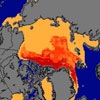 Interesting times in the Arctic, as spring turns into summer and the sea ice melts towards its summer minimum. Will this year’s minimum be a new record, or will the ice bounce back towards the long term (but still downward) trend? The first scientific forecasts of the season are expected soon from the Sea Ice Outlook project coordinated by ARCUS, the first yacht has set sail for an attempt to get through the Northwest Passage, and the usual suspects are insisting that the ice is continuing to recover. So what are the odds of a new record this year, and how is the ice really doing at the moment? The picture’s mixed…
Interesting times in the Arctic, as spring turns into summer and the sea ice melts towards its summer minimum. Will this year’s minimum be a new record, or will the ice bounce back towards the long term (but still downward) trend? The first scientific forecasts of the season are expected soon from the Sea Ice Outlook project coordinated by ARCUS, the first yacht has set sail for an attempt to get through the Northwest Passage, and the usual suspects are insisting that the ice is continuing to recover. So what are the odds of a new record this year, and how is the ice really doing at the moment? The picture’s mixed…
Tag: betting
Melt away
 As winter turns to spring and the melt season begins, the Arctic sea ice looks to be primed for another bad summer. Multi-year ice is down to only 10% of the total extent — down from 40% during 1979-2000, and new work on ice thickness suggests that the ice cover is thinner than at any point in the recent past. At a NASA/NSIDC press conference discussing the new data, UC Boulder scientist Walt Meier commented:
As winter turns to spring and the melt season begins, the Arctic sea ice looks to be primed for another bad summer. Multi-year ice is down to only 10% of the total extent — down from 40% during 1979-2000, and new work on ice thickness suggests that the ice cover is thinner than at any point in the recent past. At a NASA/NSIDC press conference discussing the new data, UC Boulder scientist Walt Meier commented:
“We’re not set up well for summertime,” ice data center scientist Walt Meier said Monday. “We’re in a very precarious situation.” [Associated Press]
Baby, it’s cold outside
 In the make-believe world of Climate Debate Daily, where there are two sides to a great “debate” on the reality of climate change (there aren’t), a great gulf is opening between the opposing teams. Cranks are investing a great deal of (wasted) time and effort into spreading the idea that the world is cooling, while climate scientists think a new record high global temperature can’t be far away.
In the make-believe world of Climate Debate Daily, where there are two sides to a great “debate” on the reality of climate change (there aren’t), a great gulf is opening between the opposing teams. Cranks are investing a great deal of (wasted) time and effort into spreading the idea that the world is cooling, while climate scientists think a new record high global temperature can’t be far away.
In The Australian today, The Great Communicator (for it is he!) runs the cooling argument for all its worth:
Thus, using several fundamentally different mathematical techniques and many different data sets, seven scientists all forecast that climatic cooling will occur during the first decades of the 21st century. Temperature records confirm that cooling is under way, the length and intensity of which remains unknown. […] Perhaps a reassessment will finally occur when two-metre thick ice develops again on Father Thames at London Bridge, or when cooling causes massive crop failure in the world’s granary belts.
Meanwhile, in an interview with Robin McKie in The Observer, Jim Hansen nails his colours to the mast:
Deniers should show caution, Hansen insisted: most of the planet was exceptionally warm last year. Only a strong La Niña – a vast cooling of the Pacific that occurs every few years – brought down the average temperature. La Niña would not persist, he said. “Before the end of Obama’s first term, we will be seeing new record temperatures. I can promise the president that.”
There’s a collision coming…
Bright future in sales
 iPredict, the NZ-based “prediction market” has offered two new contracts based on global temperatures: will 2009 be warmer than 2008, and will 2009 set a new record for warmest year? TV3 News featured the offerings last night. In iPredict’s market, buying and selling contracts — the equivalent of stock trades in a traditional market — establishes what the market (ie, the collective wisdom of the buyers and sellers) considers to be the most likely outcome, and expresses that view in the price. At the time of writing, the $1 contract “2009 warmer than 2008” (TEMP.2009) was trading at $0.7041, indicating that the market view is that it will be. On the other hand, a new record (TEMP.2009.HIGH) was trading at $0.1840, suggesting that the market deems it unlikely.
iPredict, the NZ-based “prediction market” has offered two new contracts based on global temperatures: will 2009 be warmer than 2008, and will 2009 set a new record for warmest year? TV3 News featured the offerings last night. In iPredict’s market, buying and selling contracts — the equivalent of stock trades in a traditional market — establishes what the market (ie, the collective wisdom of the buyers and sellers) considers to be the most likely outcome, and expresses that view in the price. At the time of writing, the $1 contract “2009 warmer than 2008” (TEMP.2009) was trading at $0.7041, indicating that the market view is that it will be. On the other hand, a new record (TEMP.2009.HIGH) was trading at $0.1840, suggesting that the market deems it unlikely.
iPredict’s blog explains the thinking behind the contracts:
2009 is shaping to be an interesting year for climate science. There are, as I understand it, two camps in the climate change community. One says that greenhouse gases is a major driver of changes in climate. The second says changes in the Sun’s energy output is responsible. What makes 2009 interesting is that these drivers are expected to head in opposite directions – greenhouse gas concentrations will continue their inevitable march upwards, but the Sun’s energy is expected to continue falling. So which driver will temperatures tend to follow in 09?
Unfortunately, whether 2009 is warmer than 2008 tells us nothing about long term climate “drivers”, because there’s too much noise in the system (the variation from year to year is bigger than the signal we’re looking for — an approximate 0.2ºC per decade increase – so we need to look at long time periods to establish its existence). The swing from El Niño to La Niña — a natural oscillation — has more effect in the short term than any annual increase in CO2 forcing.
The “new record” contract is potentially more interesting, because if there is a long term upward trend (and there is) then eventually there will be a new record. That could take some time to happen, though, as Tamino demonstrated in this excellent post at Open Mind.
For what it’s worth, here’s my take. 2008 began with a very strong La Niña, which has a cooling impact on global temperatures, so unless there’s an equally strong cooling event 2009 should be warmer. On the other hand, the latest prognostication from NIWA suggests that “moderate La Niña conditions are expected to prevail into [SH] autumn”, so perhaps things may not be clear cut until much later in the year. For 2009 to set a new record, ENSO would need to swing into an El Niño early in the year, and that now looks very unlikely — hence, I would guess, the price for that contract.
To measure the market confidence in the two views on climate drivers, iPredict would need to offer longer term contracts — 2009-18 average warmer than 1999-2008, for instance, but that might not be good for active trading. There are other climate-related contracts they could offer, though, and a new record minimum for Arctic sea ice in 2009 might be a good one. That might persuade me into the market…
Santa’s blues
 What’s a Christmas icon to do, when all the ice at the North Pole disappears in summer? This startling question is posed by the latest flush of media attention to events in the Arctic. First there was a National Geographic story on June 20th speculating that the North Pole would be ice free this summer (note: this is nothing to do with record minima, just do with ice around the pole itself). This was picked up by CNN, who went to Mark Serreze of the NSIDC in Boulder, Colorado for comment:
What’s a Christmas icon to do, when all the ice at the North Pole disappears in summer? This startling question is posed by the latest flush of media attention to events in the Arctic. First there was a National Geographic story on June 20th speculating that the North Pole would be ice free this summer (note: this is nothing to do with record minima, just do with ice around the pole itself). This was picked up by CNN, who went to Mark Serreze of the NSIDC in Boulder, Colorado for comment:
“We kind of have an informal betting pool going around in our center and that betting pool is ‘does the North Pole melt out this summer?’ and it may well,” said the center’s senior research scientist, Mark Serreze. It’s a 50-50 bet that the thin Arctic sea ice, which was frozen in autumn, will completely melt away at the geographic North Pole, Serreze said.
And then everything went quiet, until The Independent in Britain (referred to as The Indescribablyoverhyped on climate matters by Stoat) picked up the story and ran with it under the headline – Exclusive: no ice at the North Pole:
It seems unthinkable, but for the first time in human history, ice is on course to disappear entirely from the North Pole this year.
They seem to be having problems with their choice of tense, and quite how they can justify the “exclusive” tag escapes me… The Drudge Report noticed, and then everyone in the world had to have a go [Telegraph, AP(*)]. Andy Revkin at DotEarth covers it well, and RealClimate chips in with its own analysis. It won’t be long before the usual denialist sites will be spluttering with indignation, despite the fact that the North Pole has a very good chance of being open ocean this summer – even if a new record minimum is not set.
None of this has any relevance to the odds of my winning my various sea-ice bets, but it does give me a chance to post a few interesting Arctic-related links from the last week… As part of its beat-up, The Independent went to Peter Wadhams, professor of ocean physics at Cambridge University, for his impressions on the changes in the Arctic, and the BBC’s been carrying a blog from Liz Kalaugher aboard a Canadian icebreaker that over-wintered near Banks Island. Interesting stuff – note Liz’s comments about the weather. Meanwhile, across the melting ice, the Russian defence establishment is beginning to get worried about the impact of melting permafrost.
(*) The AP story uncovers this truly remarkable and hitherto unnoticed fact: “That pushed the older thicker sea ice that had been over the North Pole south toward Greenland and eventually out of the Arctic, Serreze said. That left just a thin one-year layer of ice that previously covered part of Siberia.” So that ice has somehow left the land and started floating towards the Pole. Be afraid, be very afraid…
